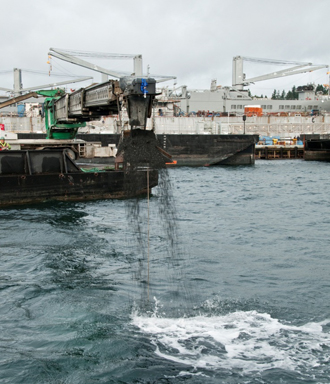ACTIVE CARBON AS A SEDIMENT REMEDIAL ALTERNATIVE
Activated carbon as a potential remedial alternative came from recent advances in the understanding of how organic chemicals partition between the sediment and water. Hydrophobic contaminants in sediments (e.g., PCBs, PAHs, dioxins) will preferentially bind to native sediment organic matter, especially to strongly sorbing “black carbons”, such as soot, coke, and charcoal. (Ghosh et al, 2000). It has been this finding that lead to the development of application of activated carbon as a sediment remedial alternative (Patmont et al 2015; EPA 2013; Ghosh et al, 2011; Rakowska et al 2012).
Completed or on-going demonstrations at DoD sites have included the Army's Aberdeen Proving Ground (ER-200835, ER-200825), Hunters Point Naval Shipyard (ER-1207), Naval Air Station Dallas (ER-1493), and the Puget Sound Naval Shipyard (ER-201131). Additional contaminated sediment sites, outside of the Programs, where AC has been applied or is being considered as a remedy are discussed further below.
|
|
- “Black carbon” refers to pyrogenic sources of carbon in the sediments, such as soot, coke, or charcoal.
-
These “black carbons” have been shown to have a strong affinity for sorbing hydrophobic organic contaminants.
- Bench-scale research confirmed that adding black carbon (as commercially-available activated carbon) strongly sorbed PCBs and PAHs.
- Application of AC thus reduced the bioavailability by tightly binding the HOCs
.
- Field trials confirmed that application of AC sequestered the HOCs, which reduced the uptake of PCBs or PAHs in field-tested benthic organisms.
|



